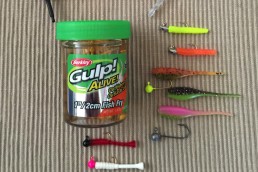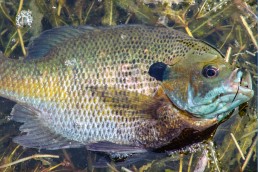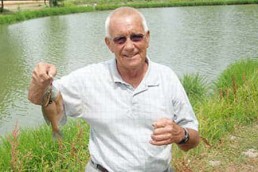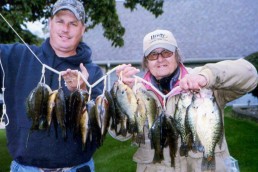Time for Bull ’Gills
SHARE THIS POST
On the Bank
By Dan Brozowski
I’m often asked how’s the fishing been? When I reply with, “I’m killin’ the bluegills right now!” I usually get that shoulder shrug and deer-in-the-headlights stare from those who’ve asked—not an unusual response when claiming bluegills were your intended quarry for a fishing excursion. Seems like stories of big crappie catches will spark a little interest, but bragging rights for a successful bluegill outing, not so much.
So, I finally questioned one of my shoulder-shrugging critics and asked about the lack of interest in my bluegill reports. “They’re kid’s fish! Besides they’re everywhere!” and “Where do you go where you can’t find hundreds of those 3- to 4-inch bait robbers?!” are the responses.
Well, I’ll have to agree with the first part of the comment, partially, as bluegills are a great species to get kids and any new angler interested in fishing. While these close-in bluegills are a bit small, they’re also very accommodating when it comes to being at the ready to bite. Beginners and kids, especially, usually could care less on the size of the fish as long as they are plentiful and tugging on the end of their lines consistently.
The other comment about bluegills being “everywhere” and smaller in size does hold a bit of weight. Not too many lakes and ponds are devoid of bluegills; many bodies of water lack proper species management and bluegills can become stunted due to over population. Just add some largemouth bass and probably that will take care of the issue.
If I find a lake or pond overrun with these stunted fish, I’ll move on to other waters. The bluegills that I’m referring to in my pursuit are some of the big “bulls.” Those are the fish that fall into that 8-inch-plus size—this size of ’gill has moved from the forage class for larger gamefish and, to actually become predators themselves.
No one can honestly dispute the battling ability these bantamweight fighters provide, once hooked. You get into an 8- to 10-inch ’gill, let them go into their signature circular fight mode, and then you will appreciate them for the stout little gamefish they are.
While bluegills don’t carry the overall size and body weight that our usual gamefish pursuits do—that’s a given—fishing with the proper tackle though will enhance your enjoyment for these battlers.
So let’s take a look at how to go about tangling with these big bull ’gills.
Big bluegills use structure like any other gamefish we pursue. But don’t confuse these bigger ’gills with the herds of smaller ones you see scurrying around in the shallows. The big bulls, except for the spawn, will be offshore and out of sight. Bluegills, like bass, will use many types of structure available whether it’s natural such as vegetation, wood or rocks, or often man-made structures such as docks, piers, concrete, etc.
Outside weedline edges are prime holding areas for big ’gills. They can cruise these edges like an underwater interstate to move about the lake, duck into cover at times to ambush food as it passes by and just retreat to the depths and safe sanctuary provided by the weed growth.
Trying to figure out the depth of these active fish will be the part of the puzzle that will be up to you. The edge of weedlines normally indicates the start of deeper water, which can cause a lack of light penetration to support deeper weeds. Deep water of course is relevant to your particular body of water, so me giving you depths will be of no use. Just keep in mind that bluegills will move up and down the water column throughout the day. You’ll have to search these depths to find the active fish, and we’ll get into a technique for this in a minute.
If you read my articles regularly, you have heard this before: When fishing for site-feeders such as bluegills, learn to present your bait down to the fish. What I mean is, when trying to find active fish, start your baits shallow, basically overhead of your fish and keep moving your presentation down to them. Do not be concerned what depth you caught them at last weekend or even the day before. Start up shallow and work your way down. Fish might have been active at 6 feet last weekend, and you fish that depth today and they’re at 3 feet—you will probably miss your bite. Learn to be consistent in your fishing approaches and success will follow.
Now that we’ve established a target zone for bull ’gills, you might be thinking the presentation might be an issue casting and retrieving over a stretch of weeds. It can be. So in my search for fishable weedline edges, I’ll limit my selections to those outside edges that are 20 feet from the bank or less to the edge of the weedline.
Are you enjoying this post?
You can be among the first to get the latest info on where to go, what to use and how to use it!
My choice of bait and presentation here is simple, as I will primarily be using a jig and float combination. I will vary the jig and sometimes the float itself, but I have found this system to be the very best for locating and catching these bluegills.
I’m also a plastics guy—I love fishing plastics on my jigs without bait for many species and bluegills are no exception. There are hundreds of styles of small jigs out there and I have a few pictured, but pick your favorites. Myself, I use primarily straight- tailed-type jigs over the swimming or twister-tail types—just my choice. But if you have a favorite, use it. Keep your bodies on the smaller size at 1 to 2 inches, and yes, big ’gills will hit the larger baits.
If you prefer to tip your lures with a bit of live bait, by all means go for it. Waxies and spikes, if you can find them, work well as do the Gulp brand add-ons.
I have a couple float choices pictured also. I’ll use floats that I can adjust up and down the line. I’ve always been a fan of Thill floats, but use the clear steelhead floats at times.
For this type of fishing, use a spinning rod and reel setup. I’m also using a long rod here, with 8- to 12-foot rods as my go-to choices. With the added interest today in crappie fishing for sport and tournaments, long rods are easy to find and can very affordable. Bass Pro Shops for example has several different series of long rods in their Crappie Maxx lineup. The longer rod will allow you to set the hook and bring these ’gills up and over the tops of the weeds with ease.
My spinning reels are loaded with either 4- or 6-pound-test mono. Smaller-diameter braids work well, but be aware of the pound-test rating on braids. I have seen anglers actually break rods when hooking a larger fish or dealing with a snag. The “Which-line-is-best?” debate goes on, mono vs. braid vs. fluoro—an argument I have no interest in pursuing. Just keep your line choices on the light side to allow the proper presentation of your bait.
Telescopic poles work well here also, but that’s almost an article of its own and I don’t have time to get in depth with them at this point. But if you have one that reaches the outside edge of the weedline, by all means use it. Same baited rig; just a different means of presenting it—very effective.
The presentation and technique is simple: Cast past the intended weedline, bring your jig and float up to the edge of the weeds, give it a second or two, and then repeat the cast. Don’t try to put too much action into this presentation, as that bait will continue to move once you stopped your retrieve. And, it’s deadly on ’gills. Move up and down the weedline a bit. If no action, simply start adjusting your float to find active fish.
This technique works exceptionally well on the outside edges of the weedlines, but if you have more of weed clumps or scattered spots of vegetation closer to the deeper water, rather than a definitive edge, use this technique the same way. The bigger bluegills will normally be on the deeper weeds.
If you never fished for these big bull ’gills, you’re missing a fantastic fishing opportunity. With the proper tackle, you will be hooked for sure. And, hey, if you’re accused of never growing up because of your pursuit of these ’gills, just say, “Thanks!” Growing up is overrated.
MWO
If you have any questions or comments you can reach Dan Brozowski at onthebank@att.net, at facebook.com/dan.brozowski.5 and on Facebook @Dan Brozowski – On The Bank- MidWest Outdoors, on Twitter @brozowski_dan and on Instagram @dbroz_angling.
MWO
SHARE THIS POST
Did you enjoy this post?
You can be among the first to get the latest info on where to go, what to use and how to use it!
Dave Mull
Dave Mull of Paw Paw, Mich. has spent his career communicating the outdoors experience and runs Inner Viking Media. He enjoys kayak fishing for anything that swims in the lakes and rivers of the Midwest and beyond, and even uses his MirroCraft, from time to time. Available for seminars.



